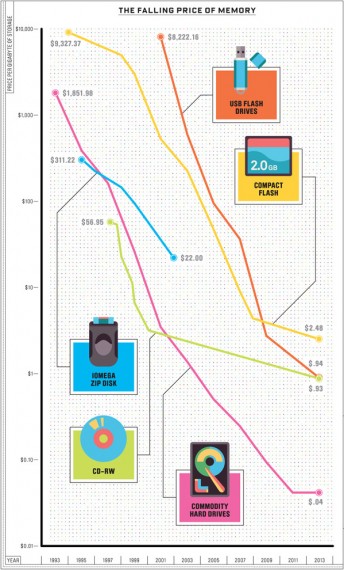Computer Memory And Storage: Cheaper Than Ever Before
Via Mark Perry comes this Wired chart that shows how the price for storage has declined while the capacity of our storage devices has increased (click to enlarge):
The microprocessor gets all the glory for dragging us into the digital age, but the modern era has been equally shaped by storage. Like chips, drives have seen Moore’s law-like advances, making it ever cheaper for us to store ever more photos, video, music, and other files — which in turn gives those microprocessors something to process. Of course, today we are nearing the end of localized, physical storage entirely, with cloud services like Google Drive offering 5 gigs for free.







I wonder if this is related to the end of Moore’s Law, and the increasing importance of parallel computing. That stuff is easier to centralize, and increasingly cheap storage means that companies can operate vast storage for shrinking amounts of money.
@Brett:
I don’t think Moore’s Law was defeated as much as requirements evolved. Proceesors are fast enough and memory is cheap enough that it is increasingly the electric bill that matters. NPR had a bit this morning on companies tackling power management in servers. I see it in my own home. I seldom really need to turn on the big 4 core workstation and should really just use the 2 core notebook. Actually a low power tablet would serve most of my needs.
@john personna: I work for a telecommunications equipment manufacturer and the low power consumption of our gear, both data and voice, is a major marketing point.
Many, many years ago I installed the very first Diablo 30 MB (you read that right) hard drive in the city of Chicago. It was a monster about 4′ X 3′ X 2′ and weighed in the vicinity of 300 lbs. I think it cost around $30,000 (when $30,000 was a lot of money). At about the same time an 8 KB (again, that’s right) core memory board weighed about 10 lbs and IIRC cost about five grand. Nowadays you can put a 16 GB of flash drive in your pocket and walk around with it. 8 GB of memory goes easily on a single chip.
I remember paying 40 bucks for 1 megabyte of ram in the early 90s. My computer’s hard drive was a massive 40 megabyte. I also spent 90 bucks on an 8 bit mono sound blaster
@Brett: Moore’s law has been a survivor and I’ll be honest in that I expected it to violated with the core processor generations.
@john personna: Yup power and heat are probably the biggest issues in a server farm environment these days. I remember reading a while back about the NSA’s problems with power management and the lack of headroom for the future.
I’ve also noticed the slow shift to more efficient low power setups. The less power they use the less heat they produce and the less you spend chilling the rooms. It’s all about the math :O
@Matt:
$79 for 16k 😉
Actual DIP packaging.
@john personna: Well played sir well played.
@Dave Schuler: My NYC high school math class was blessed with one of those under the DEC label on a PDP-8/A years after you pioneered it. Diablo used also to be synonymous with early word processing, wordstar on a micro for ex. as you surely remember. Shame what happened to DEC but otherwise good times.
(diablo as in the daisywheel interface)
@Matt:
Now we can get Raspberry Pi’s for less … UNIX systems as toys.
Shouldnt the absurdly low prices of local storage cause us to rethink the whole meme that local storage is going away? Five gigs of free storage? I can fit that on to something that fits under the fingernail of my pinky. You know what I can’t do? Use five gb of bandwidth without paying overrun fees that would exceed the amount that it would cost to buy a card that would fit below yhe fingernail of my pinky.
I’d say that the chart is incorrect, the price of hard drives went up in 2011 and I don’t think the price/GB has recovered. This because of two things; the floods in Thailand in 2011 and that there are now only 2 or 3 major manufacturers of hard drives.
@rudderpedals:
Yeah, I owned a Diablo HiType, too. I soldered my own controller board based on a 8008 to the inside of the chassis and drove the thing quite a bit faster than the rated 30 cps.
@Trumwill Mobile: But my dear! Haven’t you recognized–as one old fart computer devotee to another–that this is just Yet Another Iteration of the Centralization-Decentralization cycle we’ve been seeing since Day One?
(For myselt, I think it’s the way that the Universe keeps computer management system designers employed.)
@Trumwill Mobile:
It depends, is low price in part coming from falling demand?
I have bought probably about 20 hard disks for personal use, but I haven’t bought any in … five years?
I am probably below 20% utilization even with 3x redundancy.
And of course email, my photos, my comments, pile up in the cloud.
@grumpy realist:
I would say we are still on a hobby to appliance arc.
And many modern users are not looking for a hobby.
@Dave Schuler: Very cool. HiType doesn’t ring a bell but that’s probably because you have one and I always wanted one. At least at the time. Didn’t it need a lot of i/o and you had to handle the servos in realtime and everything else too? I’m surprised you could get even 30cps out of it without the wheel tangling in the ribbon. How did you do that? This is probably a story better told at your place, in case you add a nostalgia post and some pix of the printer (I hope you kept it)
@john personna: I don’t think so. The demand for internal, spinning (traditional) hard drives is falling, but other areas are in a boom-time. People are wanting to switch to SSD. Their Android phones, cameras, and so on have increasing need for memory cards. Not to mention internal storage on smartphones of all sorts. Pocket drives are becoming more popular. To varying degrees, whether the demand is higher or lower than in years’ past, we’ve been seeing generally lower prices for more space. Traditional hard drives are, if anything, lagging in this respect.
The cloud is great… for some things. My email, calendar, contacts, and all of that is out there. I intend to move all my baby pictures there as well. Maybe other important documents, too. (I recently had a data loss scare.) But music? Audiobooks? Videos? that can get really expensive, really fast.
As a subscriber to Rhapsody, I have access to an enormous catalog of songs. What I don’t have, however, is the ability to listen to them wherever I want. I only get 4GB of 4G data transfer and imperfect connections besides. Meanwhile, songs I actually put on the device I can listen to far more easily.
For the cloud to become this indispensable thing, it would at least be necessary for us to have better Internet infrastructure than we have in this country. Once that happens, and reliable, speedy connection virtually unlimited bandwidth to the Internet is a reality, then we’ll talk about the cloud actually supplanting local storage. Maybe.
Instead, local storage keeps getting cheaper and bandwidth limitations and per-use charges are becoming more taking off.
@Trumwill:
Consider this mental exercise. Stop 100 people in a shopping mall and ask them how to do a computer back-up.
(I think you have your head in your experience, as an avid computer user, very much in that old “hobby pc” mold. That user type have always been the minority, and Steve Jobs made billions reminding us of that fact. That he ended his career introducing products with no disk and no long term storage is not coincidental.)
To put another way, a generation of people who just wanted to save their pictures, and do some light office work, were forced to become PC hobbyists. It was required to reach the goal, but for most of them it was not the goal. It was a chore.
You can say “wait, they should still be hobbyists,” but that is putting the chores upon them.
@john personna: There will be much money to be made in automatic, brainless syncronization. But people know how to handle files, copy them to and from their device and their computer. That’s the important part.
Steve Jobs gave us iTunes, which is file-based. The iPhone and iPad both come with local storage. Neither are entirely cloud-dependent. iOS apps are also stored locally. It would be an utter disaster if he’d tried it any other way.
Honestly, I very much buy into the iOS/Android model (very cloud-friendly, low-maintenance) supplanting the Windows model. But there will still be hard drives.
I’m not expecting them to become hobbyists. I am expecting that they will expect their stuff to work. If their stuff requires the Internet to work, it won’t work too much of the time. That’s the problem.
The gold star will go to whomever can get local hard drives and the cloud to work together with as little input as possible from the user.
@Trumwill:
There were some good pilot projects in the 70’s and 80’s of distributed operating systems spanning a department. Every increment of CPU, memory, and storage was additive to the whole. It worked great, if you built it as a system. Even then they had applications that migrated between nodes, looking for spare resources.
The further you get from research labs, the harder it was to get people to buy integrated systems. Even businesses wanted a mix, with an HP printer talking to a Cisco router, talking to 3 or 4 flavors of computers. (Heh, remember NetWare?) Or maybe a string of Apollo workstations in a Dec shop …
Families are even more mixed and matched, both in type and in time. As much as Apple wanted to make an all-Apple recent-vintage home … well, they couldn’t depend on it, could they? They had to support the odd Sony camera and the odd Windows PC demanding iTunes.
That actually is a big reason why the appliance guys moved the the cloud. No reason to ask which version Windows the hand-me-down computer is on, to get it into the distributed mix. You just demand a current browser, and connect it to the cloud.
(BTW, “June 2011: With the release of iCloud, you can now redownload music, app, and ebook purchases. In order to use these features, you’ll need iTunes 10.3 or higher … blah blah”)
@john personna: The ability to re-download stuff (or download from their servers directly to your device rather than copying them from your computer is exactly the sort of cloud-local cooperation I am talking about.
But you still want to be able to download it to your device rather than just being able to stream it. I’d also kind of like to be able to have it even if my subscription expires (with Audible, unlike audible). When I’m not connected to the Internet. In other words, I sometimes want a local copy of it.
Just like I don’t want my word processor to stop working because I’ve entered a deadzone. Or I’m on an airplane. Or I am running low on my monthly bandwidth from Verizon.
So… teamwork! The Cloud for this, local storage for that.
To Date Myself:
DEC PDP-11
XEROX Sigma 7 – rotating drum memory swaps (sort of like today’s cache)
DEC 10 – powerful machine
My college didn’t bother putting heating into the Computer Science building as cooling was the issue
I never used Hollerith cards (but classmates did in the same courses), and I did batch jobs to run after midnight. Back-up was yellow punch tape, ugh. Daisey Wheel Printers, yep, did my final versions of my term papers on them (with a personally bought film ribbon so it looked like a regular $$$IBM Selectric typewriter most everyone else was using – I paid for extra time on the time-shared (60+ user) computers)
However if you exclude games and graphics the basic functions don’t need all that much. Sandia National Labs is still producing radiation hardened (for solar flares (or EMP)) Pentium II/III chips the size of dinner plates to control satellites. Even a Pentium is overkill for simply controlling a satellite. The Gemini Project computers (similar to the SSBN navigation computers to 1995) only had 64-bit memory sticks (bit, not kilobit, not megabit). At over $30k each.
My first personal PC was a 386/25. 25Mb HD, 524K memory(?) running DOS. A month later the much awaited MS Windows 3.1 came out and upon installation I found out my 386 chip wouldn’t go into the XYZ mode (enhanced?) Back then ~10% of the chips were defective. Took it back and they replaced my CPU.
Except for graphics/video that old computer ran Quicken, Turbotax, Wordperfect, powerpoint (barely). The operating system was lucky to run 2 days without crashing, and you had to reinstall the OS every 6 months. Backups were essential. You lost data in the crashes, blue screen of death….
Remember:
WordStar (F-Editor)
WordPerfect
Terak Computers with 8” floppies
AN/UYK-7 military processors
COBOL, BASIC, FORTRAN, LISP
Related:
Cognitive Overhead, Or Why Your Product Isn’t As Simple As You Think
@RGardner: And rotating core wins the thread’s old timer badge. Was it reliable?
Many years later (late 70s) RCA had a booth at a computing show showing off their COSMAC (want to say 1802, a cmos processor with a weird architecture with lots of registers) touting it for space applications. I’d be surprised if it clocked faster than 1mhz.
As a high school guest I could get dialin time (at 110 baud) to a large DEC mainframe at Columbia U but had to do it after 10pm, and pay message unit charges for the local call.